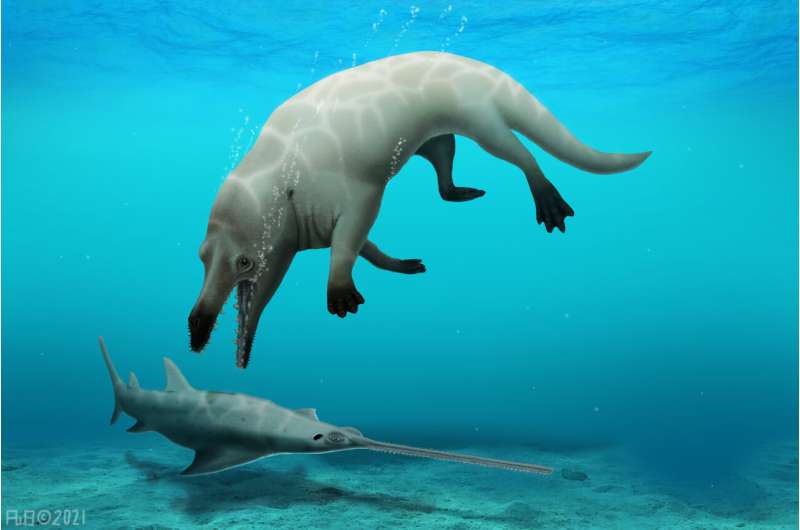September 1, 2021 report
Analysis of new species of ancient four-legged whale published

An international team of researchers led by a group at Mansoura University Vertebrate Paleontology Center (MUVPC), has released their long-awaited analysis of a fossil unearthed in Egypt 13 years ago. As they note in their paper published in Proceedings of the Royal Society B, the fossil represents a new species of ancient four-legged whale.
The fossilized partial skeleton was found encased in rock in the Fayum Depression, an area in the desert west of the Nile in Egypt that has given up many different fossils over the years—prior research has shown that millions of years ago, the area was under the sea. After its discovery in 2008, the fossil was given to MUVPC, where it has been under study ever since.
Study of the whale showed it to have lived approximately 43 million years ago, putting it in the Eocene Epoch. Measurements showed it to have been approximately three meters long when alive and to have weighed approximately 590 kilograms. It also had four fully-functional legs that would have allowed the creature to walk on land as easily as it swam in the sea. It had a mouthful of teeth and a build suggesting strength and ferocity. The researchers suggest it likely fed on smaller mammals, crocodiles and other whale calves. They also found that the fossil represents a new species of whale, which the team has named Phiomicetus Anubis—and it represents the oldest semi-aquatic species ever found in Africa. The first part of its name comes from the location where it was found, while the second part is a reference to the ancient Egyptian god of death.
The researchers believe the whale also represents an example of an ancient land creature returning to the sea—one still in the beginning stages of transitioning to a marine animal without legs. This lends credence to theories that suggest modern whales evolved from ancient land creatures. It also belongs to a group of extinct whales known collectively as protocetids. The first of their group is believed to have appeared in Asia as far back as 50 million years ago, which suggests P. Anubis is one of the oldest specimens of the group ever found.
More information: Abdullah S. Gohar et al, A new protocetid whale offers clues to biogeography and feeding ecology in early cetacean evolution, Proceedings of the Royal Society B: Biological Sciences (2021). DOI: 10.1098/rspb.2021.1368
Journal information: Proceedings of the Royal Society B
© 2021 Science X Network





















